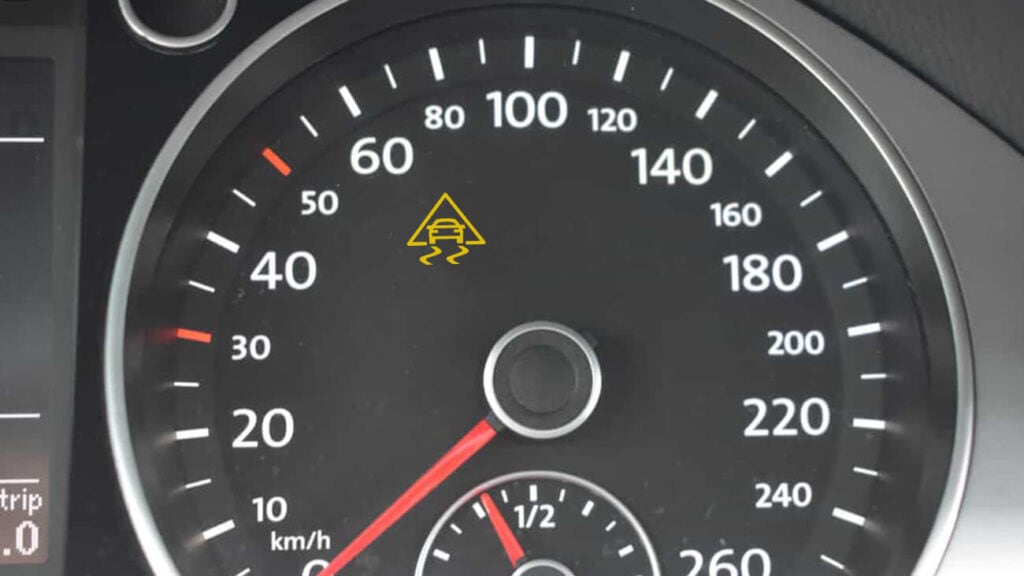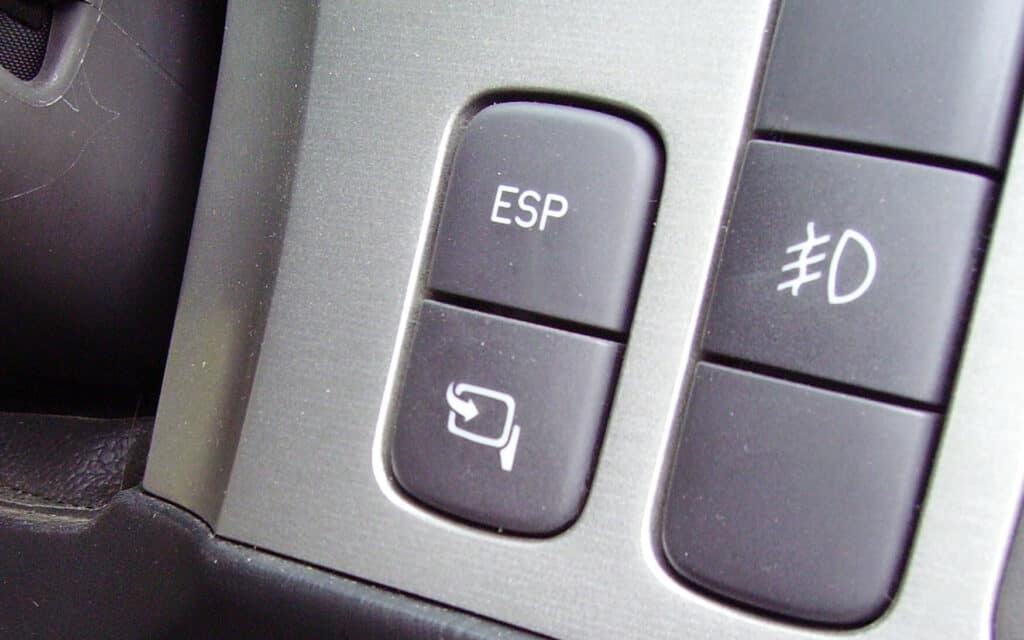Balancing on Four Wheels – The Role of ESP
Electronic Stability Control (ESP) plays an instrumental role in maintaining your vehicle’s balance, especially during challenging driving conditions. This system continually monitors your car’s direction and compares it with where the steering wheel is turned. If they don’t match, ESP intervenes to help steer the car in the desired direction. This level of oversight ensures optimal stability, even when you’re maneuvering tight turns or slippery surfaces.
Reading the Dashboard: Decoding the ESP Warning Light
• Dashboard’s Light Display: A distinct light on your dashboard, often representing a car with trailing curvy lines, indicates the ESP system’s status.
• ESP Activation Alert: The illumination of this light serves as an alert to the driver.
• Indicating Potential Issues: When this light stays on, it might suggest a potential malfunction or issue with the ESP system.
• Signal of Active Use: If the light illuminates during specific driving conditions, it’s likely indicating the ESP system’s active intervention to ensure vehicle stability.
• Distinguishing From Other Lights: The ESP warning light is unique in design, different from other dashboard lights, making it essential for drivers to recognize and understand its importance.

ESP in Action: Understanding the Mechanism Behind Stability Control
At the heart of the ESP system lies a sophisticated array of sensors that work tirelessly to monitor the vehicle’s movement and direction. As drivers, we might not always realize when the car starts to lose its grip on the road, especially during abrupt turns or on slippery surfaces. But the ESP system, with its intricate sensors, catches these deviations in real-time. The moment any skid or drift is detected, the system instantaneously processes this data.
Upon processing, the ESP doesn’t just stop at detection. It’s an active participant in ensuring safety. The system adjusts the engine power and strategically applies brake force to specific wheels. This targeted intervention helps counteract the skid, bringing the vehicle back in line with the driver’s intended direction. The brilliance of ESP lies in its ability to intervene almost imperceptibly, offering a seamless driving experience while enhancing safety.
The Triggers: Common Reasons for the ESP Warning Light Activation
• Routine Activation: The ESP light can turn on during standard vehicle operations, such as when driving on slippery or wet roads.
• Persistent Illumination: A constant ESP light, especially outside of challenging driving conditions, can indicate system malfunctions.
• Faulty Wheel-Speed Sensors: One common reason for the ESP light activation is malfunctions in the wheel-speed sensors.
• Brake Pedal Switch Issues: Problems with the brake pedal switch can also trigger the ESP light.
• Steering Angle Sensor Malfunctions: Faults in the steering angle sensors are another common cause for this light.
• Temporary System Glitches: Sometimes, the light’s activation might just be due to a system glitch, which might require a simple reset to resolve.
Safety First: Risks and Implications of Driving with an Active ESP Light
It’s easy to overlook a small light on the dashboard, especially when the vehicle seems to operate normally. However, when it comes to the ESP warning light, drivers should exercise caution. This light serves as a sentinel, warning of potential issues with the vehicle’s primary safety mechanism designed to prevent skids and maintain stability.
Continuing to drive with an active ESP light can pose significant risks. The ESP system’s primary function is to assist drivers in maintaining control during unpredictable situations. Without its intervention, sudden maneuvers, especially in unfavorable conditions, can lead to unintended skids or drifts. In essence, ignoring the ESP light not only compromises the technological assistance the vehicle offers but can also lead to precarious driving situations.
Locating and Troubleshooting: The ESC Sensor and System Check
The ESC system, often synonymous with ESP, is an intricate web of technology. Integral to this system is the ESC sensor, strategically positioned near the wheels. These sensors serve as the eyes of the system, continually gauging the speed of each wheel and ensuring they’re in sync with the driver’s intentions.
For those experiencing persistent issues with the ESP light, a good starting point is to inspect these crucial sensors. Over time, they can accumulate debris, dirt, or even sustain damage due to various external factors. These impediments can interfere with their functioning, leading to false alerts or system malfunctions. A regular sensor check can help identify and rectify issues early on, ensuring the continued efficacy of the ESP system.
Maintenance and Costs: Navigating Repairs and Financial Implications
• Prompt Attention Needed: Addressing an active ESP light without delay is crucial for both safety and potential cost savings.
• Potential Repairs: Depending on the underlying issue, the vehicle might need sensor replacements or system recalibrations.
• Varied Costs: Repair costs can differ based on the vehicle’s make, model, and the specific nature of the ESP issue.
• Cost-Effectiveness of Proactive Care: While addressing ESP concerns might come with a cost, proactive maintenance and timely intervention can prevent more significant and more expensive issues down the line.
• Safety Implications: Beyond financial considerations, ensuring the ESP system is functioning correctly is paramount for safe driving experiences.

Turning the Tables: When and How to Turn Off the ESP
While the ESP system is designed for safety, there are certain scenarios where temporarily disabling it can be beneficial. Imagine being stuck in thick mud or deep snow. In such situations, allowing the wheels to spin without the interference of the ESP can aid in freeing the vehicle. It’s akin to giving the car a bit of wiggle room to maneuver itself out.
Most modern vehicles come equipped with a dedicated button or switch to disable the ESP. This provision offers drivers the flexibility to control the system based on specific situations. However, it’s paramount to remember that this is a temporary measure. Once out of the challenging situation, it’s crucial to reactivate the ESP. Keeping it turned off compromises the safety features of the vehicle, especially when navigating regular road conditions.
Steady Driving with an Informed Mind
As vehicles continue to integrate advanced technology, understanding these features becomes vital for safe driving experiences. Electronic Stability Control is no exception. Equipped with the knowledge of its function and importance, drivers can confidently tackle various road conditions. And remember, if ever in need of expert guidance on ESP or any vehicle-related issue in Canada, Uchanics mobile mechanic services stand ready to assist. Safe travels!
